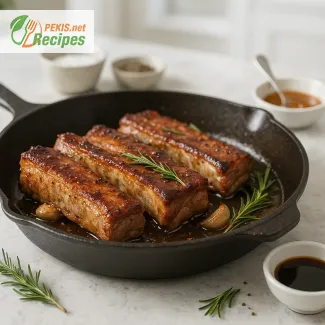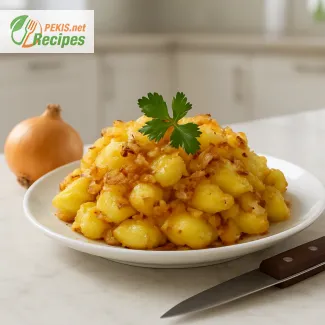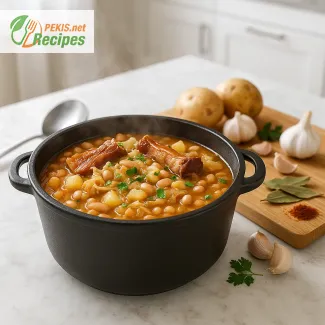The Crispy Pork Schnitzel with Classic Potato Salad delivers a comforting balance of golden crunch and cool, tangy softness. Thin, tender pork cutlets wrapped in a shatteringly crisp coating bring a touch of Central European tradition to every bite, while the gently seasoned potato salad adds nostalgic warmth. Inspired by old-family recipes passed down through German and Austrian kitchens, this dish blends contrasting textures—crisp, juicy, velvety—into one deeply satisfying meal.
Years of working with traditional European comfort dishes make it easy to recognize when a schnitzel has that perfect golden crust and when a potato salad has the right balance of softness and tang. The small details—how thin the cutlets are, how warm the potatoes stay while absorbing the dressing—shape the entire experience and give this recipe its homely charm.
PEKIS – professional chef and recipe developer with more than 25 years of experience in cooking and baking, specializing in European and international cuisine.

Golden, Juicy Pork Schnitzel Served with a Refreshing Potato Salad
A comforting Central European classic with irresistible textures and warm homestyle notes
The first moment the fork breaks through the crispy, golden crust releases a gentle crackle that instantly hints at the tenderness hidden inside. Pork this thin, this perfectly pounded and coated, carries a kind of homely drama—each bite blending a buttery crunch with meat so juicy it feels almost nostalgic. The pairing with a cool, gently seasoned potato salad adds a refreshing balance: soft potatoes that hold their shape, a mild tang, and that smooth, velvety dressing that ties everything together. It’s the kind of dish that feels familiar even if you’ve never eaten it before, a plate that brings warmth, comfort and a sense of understated luxury.
Stories of schnitzel often echo across borders, from old Viennese inns to family kitchens in Germany, each version shaped by local traditions. The combination with potato salad—rather than fries or bread—has roots in regions where cooks preferred something lighter and more vibrant to match the richness of the fried cutlet. The cool salad cuts through the warm crust, giving the meal both balance and character, which is why this pairing has remained not just popular but beloved for generations.
Thin pork cutlets, seasoned simply, respond beautifully to a breadcrumb coating that seals in moisture during frying. The choice of potatoes matters too—waxy varieties keep their structure, absorbing the dressing without turning mushy. Vinegar, mustard, onions or broth each play a role, depending on the regional style, influencing the salad’s final texture and flavor profile. When everything comes together, the harmony of crunchy, creamy, tangy and tender elements creates an experience that feels complete and deeply satisfying.
In some versions, cooks use warm potatoes to help the dressing cling better; others let the salad rest in the refrigerator for a smoother, more settled flavor. Both approaches work beautifully, depending on whether you prefer a bright, lively bite or a more mellow and rounded taste. And if you enjoy classic European desserts, it’s easy to continue the theme with familiar pairings—this dish naturally sits alongside old-world sweets such as apple strudel or silky sauces. If you like exploring connected flavors, you can also discover the English recipe for a smooth vanilla dessert sauce: Silky homemade vanilla sauce recipe for desserts and puddings.
Origins and cultural background
Schnitzel likely evolved from earlier Italian dishes before becoming a cherished staple across Austria and Germany. Potato salad followed a different path: introduced through local agriculture, adapted through wartime efficiency, and forever tied to gatherings, celebrations and Sunday meals. Together they represent a union of practicality and indulgence—simple ingredients elevated through technique and care.
Storage and make-ahead guidance
The potato salad develops deeper flavor after resting, making it ideal for preparing a few hours in advance. The schnitzel, on the other hand, is best enjoyed fresh to maintain its crisp exterior. If necessary, it can be gently reheated in the oven to revive some of the texture, but frying just before serving provides the best result. Leftovers should be stored separately so the salad doesn’t soften the coating.
Ingredient-driven flavor structure
Understanding how each element influences the dish makes the experience more intuitive:
- Breadcrumbs create the essential crunchy coating.
- Eggs bind the crust and help it adhere securely.
- Pork cutlets behave best when evenly pounded for consistent cooking.
- Potatoes deliver softness and structure.
- Mustard or vinegar adds brightness.
- Onions, herbs or broth introduce aroma and depth.
Why you’ll love this dish
- Comforting textures that balance crisp and creamy elements
- Versatile flavor profile suitable for any season
- Simple ingredients with impressive results
- Familiar, homestyle appeal that works for both everyday meals and gatherings
- Naturally balanced dish combining richness and freshness
Creative variations
- Replace pork with chicken for a lighter, equally crispy alternative.
- Add fresh herbs to the breadcrumb mixture for aroma.
- Use a warm potato salad with broth for a more rustic approach.
- Swap mustard styles to adjust the salad’s sharpness.
- Add capers or pickles for a tangier finish.
Halfway through exploring similar recipes, many cooks also enjoy traditional desserts that pair beautifully with this classic meal. For example, you can explore another English recipe that complements these flavors: Classic Apple Strudel with Homemade Vanilla Sauce Recipe.
Ingredient and preparation insights: a semantic overview
Understanding the role of frying techniques, starch varieties, acidity in dressings, and breading structure helps bring confidence to the cooking process. Moisture levels in the cutlet influence crispness; potato types determine firmness; acidity shapes the salad’s brightness; oil temperature ensures even browning. When these elements align, the dish expresses its full savory, warm, balanced character.
Additional helpful notes
- Resting periods enhance flavor cohesion in the salad.
- Consistent slicing of potatoes improves texture balance.
- Allowing the schnitzel to drain properly keeps the crust light.
- Adjusting acidity helps tailor the salad to personal tastes.
- Place the potatoes in a pot, cover with cold water, bring to a boil, then cook until tender (about 20 minutes). Drain, let cool slightly, peel, and slice into even rounds.
- In a bowl, combine warm vegetable broth, vinegar, mustard, salt and pepper. Whisk until smooth, then pour over the warm potatoes so they can absorb the dressing well.
- Add finely chopped onion and vegetable oil, then gently fold until the salad is evenly coated. Let rest for 20 minutes to develop flavor.
- Place each pork cutlet between two sheets of plastic wrap and pound evenly to about 0.6 cm thickness (¼ inch).
- Season both sides with salt and pepper.
- Prepare three bowls: one with flour, one with beaten eggs, one with breadcrumbs.
- Dredge each cutlet in flour, dip in egg, then coat in breadcrumbs, pressing to ensure an even layer.
- Heat vegetable oil in a large pan to medium-high (about 170°C / 338°F).
- Fry schnitzel in batches, 2–3 minutes per side, until golden and crisp. Drain on paper towels.
- Serve the schnitzel immediately with the potato salad and garnish with fresh parsley.
FAQ questionHow do I keep pork schnitzel really crispy while the inside stays juicy?
The key is to combine thin, evenly pounded cutlets with a proper breading sequence and the right oil temperature. Pound the pork to an even thickness so it cooks quickly without drying out. Dredge in flour, then dip in beaten egg, then coat in fine, dry breadcrumbs, pressing them in gently so they adhere well. When frying, the oil should be hot enough for steady bubbling around the schnitzel but not smoking (around medium-high heat). If the oil is too cool, the crust absorbs fat and turns soggy; if it’s too hot, the outside burns before the inside is cooked. Let the schnitzel rest briefly on a rack or paper towel to drain, but serve it immediately to preserve maximum crunch.
FAQ questionWhat are the best potatoes for classic German-style potato salad?
For a traditional potato salad to serve with schnitzel, use waxy potatoes that keep their shape after boiling. Varieties like Yukon Gold or other firm, low-starch types are ideal because they become tender but not crumbly. Boil them whole with the skin on, just until a knife slides in easily, then peel and slice them while still warm. Warm potatoes absorb the dressing better, creating a salad that is creamy and well seasoned without turning into mash. Avoid very starchy potatoes, as they tend to fall apart and make the salad heavy and gluey.
FAQ questionShould the potato salad be served warm or cold with schnitzel?
Both are possible, but for a classic Central European feel, the potato salad is often served slightly warm or at room temperature. When the potatoes are still warm, they bind more intimately with the broth-vinegar dressing, giving the salad a smooth, almost silky texture. This mild warmth contrasts beautifully with the hot, freshly fried schnitzel, creating layers of temperature and texture on the plate. If prepared ahead and chilled, the salad becomes firmer and more mellow in flavor; in that case, let it sit at room temperature for a short time before serving so the taste can open up.
FAQ questionWhich oil is best for frying schnitzel evenly and safely?
Choose a neutral oil with a medium-high smoke point, such as refined sunflower, canola or vegetable oil. These oils allow you to maintain a stable frying temperature without burning or adding unwanted flavors. Use enough oil to create a shallow frying depth so the schnitzel can float slightly and brown evenly, and avoid overcrowding the pan, which would cool the oil and lead to greasy results. Keeping the heat consistent and frying in batches produces a uniform golden crust that stays light instead of heavy.
FAQ questionCan I make pork schnitzel and potato salad in advance for guests?
Parts of the dish adapt very well to advance preparation. The potato salad can be made several hours ahead, or even the day before, because resting time helps the flavors meld and the dressing soak into the potatoes. Simply stir it gently before serving and adjust seasoning if needed. Schnitzel is best fried shortly before serving so the coating remains crisp. However, you can bread the cutlets in advance and keep them covered in the refrigerator for a few hours, then fry them just before guests arrive. If you need to reheat, do it in a moderately hot oven on a rack to help revive some of the crunch.
FAQ questionHow can I adapt this schnitzel with potato salad for dietary needs?
There are several ways to adjust the dish without losing its comfort-food character. For a lighter version, you can use lean pork or swap in chicken or turkey breast, while keeping the same breading method. To reduce gluten, choose gluten-free breadcrumbs and flour, and make sure mustard and broth are certified gluten-free. For those watching fats, fry the schnitzel in a bit less oil in a nonstick pan and increase the proportion of herbs, onions and vinegar in the potato salad to keep strong flavor with less richness. Small changes in coating, oil quantity and dressing composition make it easier to match personal dietary preferences while staying close to the original experience.
The harmony of crispy pork schnitzel and creamy potato salad creates a balanced, comforting meal that resonates with both tradition and modern cooking. Each element carries its own character—one defined by a golden, shatteringly crisp coating, the other by a smooth, tangy dressing that gently coats warm potatoes. Together, they form a plate that feels familiar, satisfying and deeply rooted in Central European home cooking.
Consistency in texture is what makes this dish stand out. Evenly pounded cutlets, properly coated breadcrumbs and well-controlled frying lead to a crust that stays crisp from the first bite to the last. The salad provides contrast, its velvety texture and balanced acidity working as a refreshing counterpart to the richness of the schnitzel. This combination of crunch, softness and bright flavor creates a sensory experience that appeals to both everyday cooks and culinary enthusiasts.
A recipe like this thrives on small details: the temperature of the oil, the warmth of the potatoes, the resting time that allows the dressing to settle. These nuances elevate a simple meal into something more polished and satisfying. Each step contributes to a dish that feels complete and thoughtfully composed.
Whether served for a family dinner, a casual gathering or a comforting weekend treat, it’s a meal that invites people together. The familiar aromas, the crisp texture and the contrast of warm and cool components make it a plate that delivers comfort without losing refinement.
Allergens present in the recipe:
- Eggs – used for breading
- Gluten – present in breadcrumbs and flour
How to remove allergens and gluten:
- Replace breadcrumbs with gluten-free breadcrumbs.
- Replace flour with gluten-free flour.
- Replace eggs with a plant-based egg substitute suitable for breading.
- Vitamin C (mg): 18 – contributes to immune support
- Iron (mg): 2.2 – supports oxygen transport
- Potassium (mg): 780 – essential for fluid balance and nerve function
- Vitamin B6 (mg): 0.6 – supports metabolism
- Magnesium (mg): 48 – contributes to muscle and nerve health
- Carotenoids (mg): 0.4 – support healthy cells
- Flavonoids (mg): 22 – contribute to cellular protection
- Phenolic compounds (mg): 18 – support overall antioxidant defense





